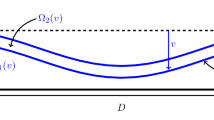Abstract
We study the existence, uniqueness, and optimal regularity of solutions to transmission problems for harmonic functions with \(C^{1,\alpha }\) interfaces. For this, we develop a novel geometric stability argument based on the mean value property.


Similar content being viewed by others
References
Blank, I., Hao, Z.: The mean value theorem and basic properties of the obstacle problem for divergence form elliptic operators. Commun. Anal. Geom. 23, 129–158, 2015
Caffarelli, L.A.: Elliptic second order equations. Rend. Sem. Mat. Fis. Milano 58, 253–284, 1988
Campanato, S.: Sul problema di M. Picone relativo all’equilibrio di un corpo elastico incastrato. Ricerche Mat. 6, 125–149, 1957
Campanato, S.: Proprietà di hölderianità di alcune classi di funzioni. Ann. Scuola Norm. Sup. Pisa Cl. Sci. (3) 17, 175–188, 1963
Citti, G., Ferrari, F.: A sharp regularity result of solutions of a transmission problem. Proc. Amer. Math. Soc. 140, 615–620, 2012
Evans, L.C., Gariepi, R.F.: Measure Theory and Fine Properties of Functions. Studies in Advanced Mathematics. CRC Press, Boca Raton 1992
Ladyzhenskaya, O.A., Ural’tseva, N.N.: Linear and Quasilinear Elliptic Equations. Academic Press, New York 1968
Li, Y., Nirenberg, L.: Estimates for elliptic systems from composite material. Dedicated to the memory of Jürgen K. Moser. Commun. Pure Appl. Math. 56, 892–925, 2003
Li, Y., Vogelius, M.: Gradient estimates for solutions to divergence form elliptic equations with discontinuous coefficients. Arch. Ration. Mech. Anal. 153, 91–151, 2000
Lions, J.L.: Contributions à un problème de M. M. Picone. Ann. Mat. Pura Appl. 4(41), 201–219, 1956
Maggi, F.: Sets of Finite Perimeter and Geometric Variational Problems. An Introduction to Geometric Measure Theory, Cambridge Studies in Advanced Mathematics, vol. 135. Cambridge University Press, Cambridge 2012
Mateu, J., Orobitg, J., Verdera, J.: Extra cancellation of even Calderón–Zygmund operators and quasiconformal mappings. J. Math. Pures Appl. (9) 91, 402–431, 2009
Milakis, E., Silvestre, L.E.: Regularity for fully nonlinear elliptic equations with Neumann boundary data. Commun. Partial Differ. Equ. 31, 1227–1252, 2006
Picone, M.: Sur un problème nouveau pour l’équation linéaire aux dérivées partielles de la théorie mathematique classique de l’élasticité. Colloque sur les équations aux dérivées partielles, Bruxelles May 1954
Schechter, M.: A generalization of the problem of transmission. Ann. Scuola Norm. Sup. Pisa Cl. Sci. (3) 14, 207–236, 1960
Stampacchia, G.: Su un problema relativo alle equazioni di tipo ellittico del secondo ordine. Ricerche Mat. 5, 3–24, 1956
Acknowledgements
We would like to thank the referees for some very valuable remarks that helped us improve the presentation of this paper.
Author information
Authors and Affiliations
Corresponding author
Additional information
Communicated by A. Figalli
Publisher's Note
Springer Nature remains neutral with regard to jurisdictional claims in published maps and institutional affiliations.
Appendix
Appendix
A special Lipschitz domain \(\Omega \) in \(\mathbb {R}^n\) is a set of the form
where \(\psi \in {\text {Lip}}(\mathbb {R}^{n-1})\), that is, there exists \(M>0\) such that
In other words, \(\Omega \) is the set of points lying above the graph of a Lipschitz function \(\psi \). Then, by Rademacher’s Theorem, \(\psi \) is Fréchet differentiable almost everywhere with \(\Vert \nabla \psi \Vert _{L^\infty (\mathbb {R}^{n-1})}\le M\). On \(\partial \Omega \) we thus have
where \(x=(x',\psi (x'))\in \partial \Omega \). For a measurable function f on \(\partial \Omega \), we have
A bounded Lipschitz domain in \(\mathbb {R}^n\) is a bounded domain \(\Omega \) such that the boundary \(\partial \Omega \) can be covered by finitely many open balls \(B_j\) in \(\mathbb {R}^n\), \(j=1,\ldots ,J\), centered at \(\partial \Omega \), such that
where \(\Omega _j\) are rotations of suitable special Lipschitz domains given by Lipschitz functions \(\psi _j\). One may then assume that \(\partial \Omega \cap B_j\) can be represented in local coordinates by \(x_n=\psi _j(x')\), where \(\psi _j\) is a Lipschitz function on \(\mathbb {R}^{n-1}\) with \(\psi _j(0')=0\). Recall also that if \(\psi \) is a Lipschitz function defined on an set \(A\subset \mathbb {R}^{n-1}\), with Lipschitz constant M, then there exists an extension \(\overline{\psi }:\mathbb {R}^{n-1}\rightarrow \mathbb {R}\) of \(\psi \) such that \(\overline{\psi }=\psi \) on A and the Lipschitz constant of \(\overline{\psi }\) does not exceed M, see [6].
Let \(\Omega _0=\Omega \cap \big (\bigcup _{j=1}^JB_j\big )^c\). A partition of unity \(\{\xi _j\}_{j=0}^J\) subordinated to \(\{\Omega _0,B_1,\ldots ,B_J\}\) is a family of nonnegative smooth functions \(\xi _j\) on \(\mathbb {R}^n\) such that
It follows that \(0\le \xi _j\le 1\), \(j=0,1,\ldots ,J\). Obviously the family \(\{\xi _j\}_{j=1}^J\) is a partition of unity subordinated to the open cover \(\{B_1,\ldots ,B_J\}\) of \(\partial \Omega \) and \(\sum _{j=1}^J\xi _j(x)=1\) for every \(x\in \partial \Omega \).
Let \(f:\Gamma \rightarrow \mathbb {R}\) be a measurable function, where \(\Gamma =\partial \Omega \) is the boundary of a bounded Lipschitz domain \(\Omega \). Consider the balls \(B_j\), \(j=1, \ldots ,J\), that cover \(\Gamma \) as above, and the corresponding Lipschitz functions \(\psi _j:\mathbb {R}^{n-1}\rightarrow \mathbb {R}\). Let \(\{\xi _j\}_{j=1}^J\) be a smooth partition of unity subordinated to the open cover \(\{B_j\}_{j=1}^J\) of \(\Gamma \). Then
Let us consider each one of the terms in the sum above separately. We study the following situation: let B be a ball and let \(\bar{f}:B\cap \Gamma \rightarrow \mathbb {R}\) of compact support in \(B\cap \Gamma \). Let \(\psi :\mathbb {R}^{n-1}\rightarrow \mathbb {R}\) be a Lipschitz function such that \(\psi (B_1')=B\cap \Gamma \). Then, by extending trivially \(\bar{f}\) to the rest of the graph of \(\psi \) and using the coarea formula [6, 11],
Remark. The contents of this work are part of the second author’s PhD dissertation. She presented these results at the AMS Fall Central Sectional Meeting at University of Michigan, Ann Arbor (Oct. 2018), the Barcelona Analysis Conference at Universitat de Barcelona (Jun. 2019), and the Midwest Geometry Conference at Iowa State University (Sep. 2019).
Rights and permissions
About this article
Cite this article
Caffarelli, L.A., Soria-Carro, M. & Stinga, P.R. Regularity for \(C^{1,\alpha }\) Interface Transmission Problems. Arch Rational Mech Anal 240, 265–294 (2021). https://doi.org/10.1007/s00205-021-01611-0
Received:
Accepted:
Published:
Issue Date:
DOI: https://doi.org/10.1007/s00205-021-01611-0




